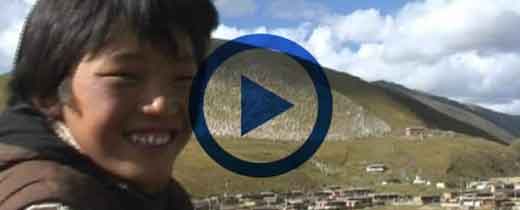Hualong Hui Autonomous County, also known as “Bayan Khar County“, is an autonomous county under jurisdiction of Haidong City.
Location
It is located in transition zone between Loess Plateau and Qinghai-Tibet Plateau in eastern of Qinghai Province. It is 110 kilometers away from provincial capital Xining. 12 ethnic groups including Han, Tibetan and Salar live in this county.
Hualong county seat is Bayan Town with an altitude of 2873 meters. It covers an area of 2740 square kilometers. Hualong County is a large migrant worker county that produces “Lanzhou Ramen”. In 2015, 14,430 ramen shops in 271 large and medium-sized cities in China achieved an operating income of 6 billion yuan (ramen income accounted for 53% of local net income per capita)
Best travel time
From May to October
Local climate
Temperate continental climate
Most popular sites
Xiaqiong Temple, also spelled as “Jakyung Shedrubling monastery“, a provincial cultural relics protection unit, is located in Cha-fu Township, Hualong County, about 95 kilometers away from provincial capital Xining. It is a religious and cultural attraction in scenic area of Hualong County. It was built in 1394. As one of the oldest Tibetan Buddhist temples in Qinghai, Xiaqiong Temple has a total area of 270,000 square meters. It is an ancient architectural complex combining Han and Tibetan artistic styles.
Ma Bufang Mansion, a county-level protection unit, it was built in two stages. The first part was built in 1925, it was residence of local warlord Ma Bufang. Its style is simple, elegant and unique. It is a typical local Chinese building
Dandou Temple is known as “Detsa Tashi Choding Monastery”, this monastery is divided into two parts, lower one is called “Detsa Gompa”, upper one is called “Detsa Tashi Choding”; both are Gelug pa monastery, and it was one of birthplaces of “The second dissemination of Tibetan Buddhism”
Geography and climate
Hualong Hui Autonomous County is connected to Minhe County to east; Xunhua County and Jianzha County are across river to south; Guide County and Huangzhong District are bordered to west; Ping An District and Ledu District are bordered to north.
Hualong Hui Autonomous County has steep mountains and ravines. The terrain is high in north and low in south, showing a stepped shape, decreasing from northwest to southeast. The whole territory is 99 kilometers long from east to west, 49 kilometers wide from north to south, the lowest elevation is 1884 meters above sea level, the highest is 4484 meters, generally altitude of most areas are between 2600-2800 meters. Yellow River flows from west to east through southwest and south of Hualong County, and it belongs to arid area of eastern Qinghai-Tibet Plateau.
Hualong County is with annual average temperature of 2.2°C, a frost-free period of 89 days, and an average annual rainfall of 470 mm. It is windy and arid in winter.
Population and ethnic group
As of 2010, Hualong Hui Autonomous County has a total population of 229,600. Main ethnic minority Hui is about 52% of total population. There are 12 ethnic groups including Tibetans, Hans, and Salars.
Brief History
In pre-Qin period, Hualong area was a pastoral land of Qiang people
In 60 BC, Hualong area was under jurisdiction of Jincheng County
In 335 AD, Hualong area was under jurisdiction of Huanghe County
In 385 AD, Hualong area belonged to Houliang
In 445 AD, Hualong area now under jurisdiction of Shanshan Town (Xining City)
In 553 AD, it was renamed Hualong County. This was beginning of using name of “Hualong County”
In 607 AD, Hualong County was under jurisdiction of Diaohe County, which was later classified as Xiping County
In 655 AD, Hualong County was under jurisdiction of Kuo-zhou
In 712 AD, Name of “Hualong County” was changed to “Huacheng County”
In 742 AD, it was renamed as Guangwei County.
In 758 AD, it was renamed as Guozhou
In 763 AD, Hualong County was under jurisdiction of Tubo kingdom
In 851 AD, Hualong County was restored to Tang dynasty
At end of Tang Dynasty, Hualong area was under rule of Tubo local forces.
In 1099 AD, after Northern Song Dynasty occupied Hehuang area, Hualong area belonged to Shanzhou
In 1137 AD, Xixia kingdom occupied Hualong area and other places,
In 1227 AD, Hualong area was under jurisdiction of Xining
In 1373 AD, Hualong area belonged to Xiningwei (Xining City)
In 2nd year of Republic of China (1913), Hualong area was attached to Xining Dao, Gansu Province.
In 18th year of Republic of China (1929), Qinghai was established as a province, and Hualong area was part of Qinghai Province
In 1953, Hualong Hui Autonomous Region was reorganized,
In 1955, it was renamed Hualong Hui Autonomous County,
In 1978, Hualong Hui Autonomous County was placed under Haidong city




